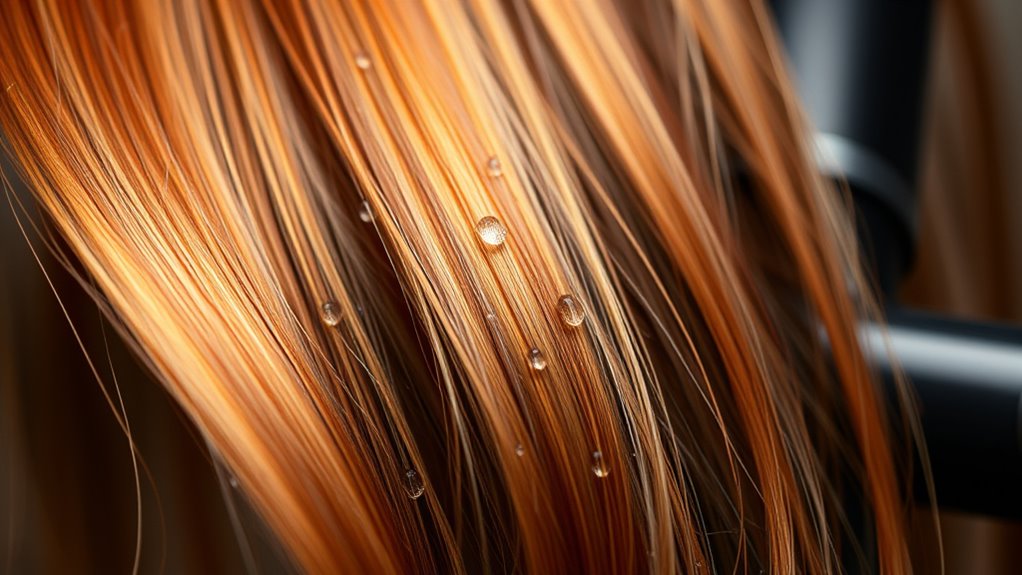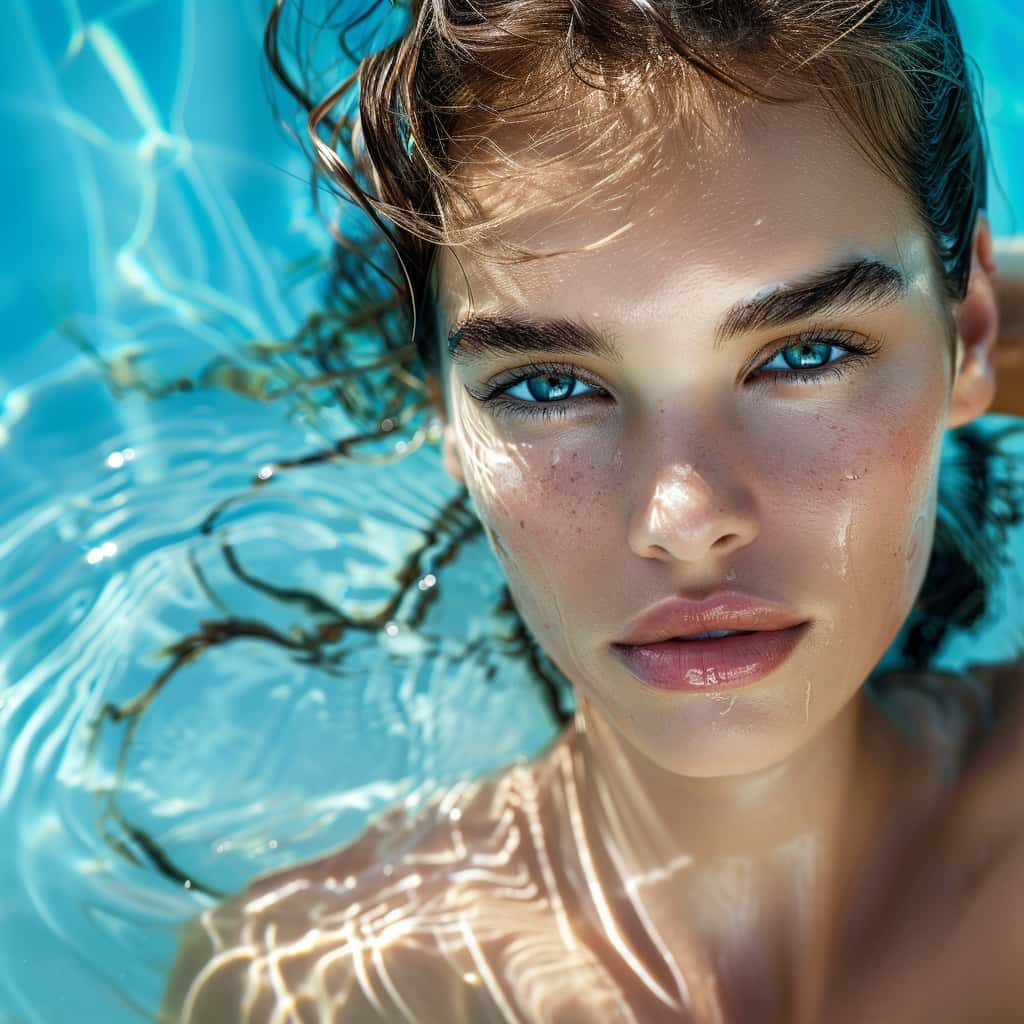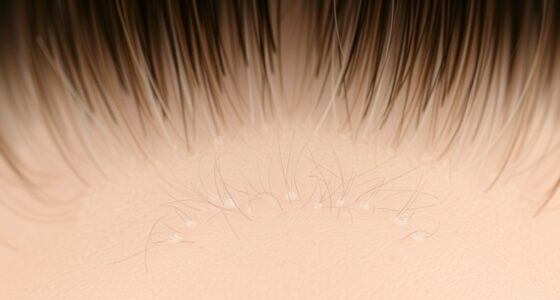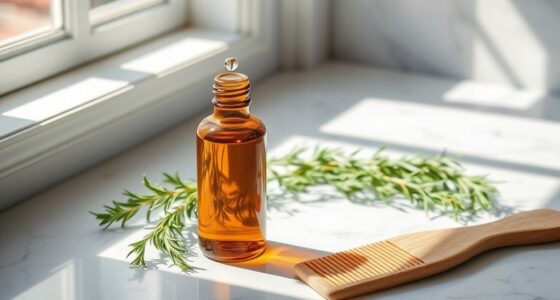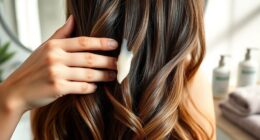To safeguard your strands, always start with a heat protectant spray before using styling tools. Use the lowest effective temperature, and avoid high settings that can weaken hair. Limit heat exposure by air-drying or opting for heat-free styles when possible. Regularly nourish your hair with moisturizing products and give it breaks during hot weather. Implementing these simple steps will help maintain healthy, shiny hair—stay with us to discover even more effective tips.
Key Takeaways
- Always apply a heat protectant spray before using hot styling tools to create a barrier against heat damage.
- Use the lowest effective temperature setting on your tools to minimize stress and prevent weakening hair strands.
- Limit heat styling frequency and incorporate heat-free methods like braiding or air-drying for healthier hair.
- Pre-dry hair on a cool setting or air-dry partially to reduce overall heat exposure during styling.
- Maintain hair health with moisturizing shampoos, deep conditioning, and avoiding tight hairstyles that cause additional stress.

Have you ever wondered how to stay safe when temperatures soar? When the heat is intense, your hair becomes more vulnerable to damage, making temperature control a top priority. You might love experimenting with different styling techniques, but high heat can quickly weaken your strands, leading to breakage and dullness. To protect your hair, it’s essential to adapt your styling routine and incorporate strategies that minimize heat exposure. First, always use a heat protectant spray before applying any hot tools. This barrier helps distribute heat evenly and reduces direct damage, allowing you to style confidently without sacrificing your hair’s health. It’s also wise to limit the use of high-temperature settings on curling irons, straighteners, and blow dryers. Instead, opt for the lowest effective temperature and gradually increase if needed. Remember, the goal is to achieve your desired look while maintaining temperature control, so take your time and avoid rushing through styling sessions.
Another key tip is to explore alternative styling techniques that don’t rely on heat. For example, braiding damp hair can create beautiful waves without any heat at all, and air-drying can give your hair a natural, healthy shine. When you do need to use heat tools, consider pre-drying your hair on a cool setting or letting it partially air-dry before applying heat. This reduces the overall temperature exposure and lessens the risk of heat damage. Also, try to limit heat styling to special occasions rather than daily routines, giving your strands time to recover. If you’re in a hot climate or working outdoors, be extra cautious—excessive sweat and humidity can compound the damage caused by heat styling, so give your hair breaks from hot tools as often as possible. Incorporating heat damage prevention techniques into your routine can further safeguard your strands.
It’s equally important to keep your hair hydrated and nourished, especially during summer months. Use moisturizing shampoos and conditioners designed for heat protection, and incorporate deep-conditioning treatments into your routine weekly. These products help fortify your hair’s cuticle, making it more resilient to heat stress. When styling, avoid overly tight hairstyles or pulling on your strands, which can cause additional stress and breakage. Ultimately, maintaining a mindful approach to temperature control and embracing versatile styling techniques will keep your hair healthy and beautiful, even in the hottest weather. By being proactive and gentle with your hair, you’ll enjoy stunning styles without sacrificing your strands’ strength and vitality.
Frequently Asked Questions
Can Heat Protectants Cause Scalp Irritation?
Heat protectants can cause scalp irritation if you have scalp sensitivity. Some products contain chemicals that may trigger allergic reactions or chemical responses, leading to discomfort or redness. To avoid this, always check the ingredient list and do a patch test before applying extensively. If you notice irritation, discontinue use and consult a dermatologist. Using gentle, sulfate-free formulas can help minimize the risk of chemical reactions and scalp irritation.
How Often Should I Replace My Heat Styling Tools?
You should replace your heat styling tools every 2-3 years, as their performance can decline over time. Did you know that worn-out tools can cause 50% more damage to your hair? Regular replacement ensures peak tool longevity and consistent results. Keep an eye on signs like frayed cords or uneven heat distribution, and don’t wait too long—upgrading maintains safe, effective styling and helps protect your strands.
Do Natural Oils Protect Hair From Heat Damage?
Natural oils can provide some protection against heat damage, but they aren’t foolproof. When you apply oils like argan or coconut before heat styling, they create a barrier that helps lock in moisture and reduce direct heat contact. However, overuse or excessive heat can still cause damage, so it’s essential to combine oils with heat protectants and avoid high temperatures for ideal hair health.
Is It Safe to Use Heat Protectant on Color-Treated Hair?
You might worry that heat protectants could affect your color-treated hair, but they’re actually safe when choosing the right product. Modern formulas contain protective ingredients designed to preserve color while shielding your strands from heat damage. Using a heat protectant regularly helps maintain your vibrant hue and prevents breakage. Just make certain you select one formulated for color-treated hair, and you’ll enjoy both color preservation and effective heat protection.
What Are Alternative Methods to Heat Styling for Volume?
You can boost your volume with volumizing techniques like teasing, using volumizing mousse, or applying dry shampoo at the roots. For heat-free styling, try braiding damp hair for waves or using rollers without heat. These methods create fullness without risking heat damage, helping your hair stay healthy while still achieving a voluminous look. Incorporate these strategies into your routine for a natural, radiant volume boost.
Conclusion
Think of your hair as a delicate garden that needs shielding from the harsh sun and scorching winds. Just like a gardener shields fragile blooms with a protective canopy, you safeguard your strands with heat protection. By doing so, you’re nurturing your hair’s health and beauty, allowing it to flourish and glow. Remember, a little protection today keeps your hair vibrant and strong tomorrow—so, guard it well, and watch your hair blossom like a well-tended garden.
Claire has a knack for turning complex dermatological concepts into engaging, easy-to-understand articles. Her work primarily focuses on creating detailed reviews and thought-provoking articles in the “Vetted” category. Claire’s writing not only informs but also inspires our community to try new skincare solutions.
